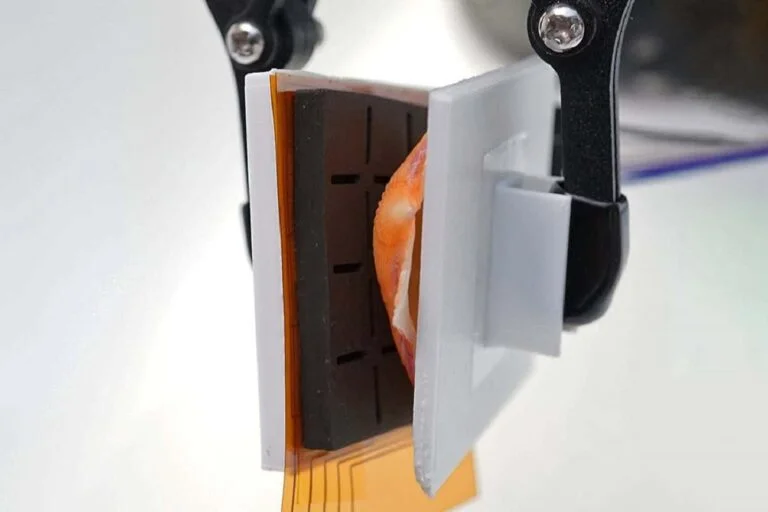Scientists have created a “magnetic skin” that can be touched
- January 9, 2024
- 0
Thanks to the new artificial skin, robots will be able to distinguish inanimate objects from living organisms. This is similar to the sense of touch in humans. To
Thanks to the new artificial skin, robots will be able to distinguish inanimate objects from living organisms. This is similar to the sense of touch in humans. To

Thanks to the new artificial skin, robots will be able to distinguish inanimate objects from living organisms. This is similar to the sense of touch in humans. To find out if there is a living creature in front of the car, all he has to do is touch it. With the help of such a skin, “smart” devices will be able to carry out underwater exploration of mineral deposits, participate in their extraction, clean the ocean of garbage without harming marine life.
Approximately 70 percent of the Earth’s surface is covered with water, mostly oceans, which play the most important role in regulating the global climate. They are a vital carbon sink, absorbing 90 percent of the excess heat released by carbon dioxide emissions and producing 50 percent of the oxygen we need.
Additionally, oceans are home to the vast majority of the planet’s flora and fauna; Thousands of species of living organisms live here. Many valuable mineral resources are also stored in the oceans: reserves of oil, gas, diamonds, gold and platinum.
Minerals on land are becoming increasingly depleted, so geologists are increasingly turning their attention to the ocean floor. However, accessing the natural resources of the World Oceans is not that easy. One of the reasons for this is the enormous pressure (600 atmospheres and above) that only rare and expensive deep-sea vessels can withstand.
Developing ocean resources requires advanced technologies, namely “smart” autonomous underwater robots that can operate at human levels. Moreover, such machines need to be equipped with special devices that allow tactile sound production to explore the bottom with the help of “touches” and thereby identify objects in front of them.
Engineers have developed a series of tactile sensors used in object and texture recognition, robotics (in adaptive grasping), and human-machine interface in various industries. But almost all of them do not work well in water, especially under hydrostatic pressure conditions.
A group of scientists from the University of California (USA) led by Jun Chen (June Chen) found a way to solve this problem. Researchers have developed a waterproof artificial skin for underwater robots; In this way, machines will be able to recognize objects in the sea with a single touch. The study was published in the journal Science Developments.
Some magnetic materials in nature can change their magnetization under the influence of mechanical deformations. This property has been observed mainly in ferromagnetic metals and alloys and is known under the name “magnetoelastic effect” or “Villari effect”. Experiments have shown that this property is not affected by water and is retained even after the magnetic material is immersed in a salty, sea-like environment for several weeks.
It was this effect that caught the attention of Chen and his colleagues. Researchers have discovered that the magnetoelastic effect can also occur in “soft” polymers, which are substances used to produce soft muscle in biomedicine and robotics, for example. Scientists used this knowledge in the development of artificial skin, which consists of a mostly elastic polymer and a series of small powerful magnets that convert any physical touch into a change in the magnetic field, and two layers of magnetic induction sensors that convert the changes. It turns into electrical signals in the magnetic field.
Chen and his team then “stretched” the skin on the robotic arm and tested it in the laboratory. The hand was supposed to randomly capture both “living targets” (mollusk, sea snail, clam, starfish) and “inanimate” marine debris (bottle cap, paper cup, plastic bottle). The artificial intelligence model, trained to decode sensor signals from the skin during grasping exercises, showed 95% accuracy in recognizing different objects.
According to the developers, the artificial intelligence-based sensor system they created does not require large computing power and can complement the vision of underwater robots. Moreover, with the help of such a system, autonomous vehicles will be able to quickly perform tasks in the ocean where it is necessary to capture objects, which will save time and money on expensive underwater missions.
Scientists believe that their development in the future could be used by deep-sea robots that explore mineral deposits on the ocean floor, as well as devices participating in cleaning oceans or seas from garbage. If the manipulator on whom the skin will be “stretched” can distinguish between “alive” and “dead”, it will not harm the inhabitants of the underwater world.
Source: Port Altele
As an experienced journalist and author, Mary has been reporting on the latest news and trends for over 5 years. With a passion for uncovering the stories behind the headlines, Mary has earned a reputation as a trusted voice in the world of journalism. Her writing style is insightful, engaging and thought-provoking, as she takes a deep dive into the most pressing issues of our time.